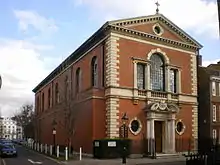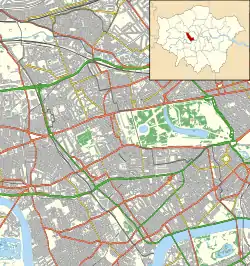Church of Our Most Holy Redeemer and St Thomas More, Chelsea
The Church of Our Most Holy Redeemer and St Thomas More, also referred to as Holy Redeemer Church, is a Roman Catholic Parish church in Chelsea, London. it was built in the 19th century and opened on 23 October 1895. It was designed by Edward Goldie. It is situated on the corner of Upper Cheyne Row and Cheyne Row, next to Carlyle's House in the Royal Borough of Kensington and Chelsea. It is listed Grade II on the National Heritage List for England.[1]
| Church of Our Most Holy Redeemer and St Thomas More | |
|---|---|
 View from corner of Upper Cheyne Row and Cheyne Row | |
 Church of Our Most Holy Redeemer and St Thomas More Location in Kensington and Chelsea | |
| OS grid reference | TQ2717177759 |
| Location | Chelsea, London |
| Country | United Kingdom |
| Denomination | Roman Catholic |
| Website | HolyRedeemerChelsea.co.uk |
| History | |
| Status | Parish church |
| Dedication | Christ the Redeemer Thomas More |
| Consecrated | 21 June 1905 |
| Architecture | |
| Functional status | Active |
| Heritage designation | Grade II listed |
| Designated | 7 November 1984[1] |
| Architect(s) | Edward Goldie |
| Style | Renaissance Revival |
| Groundbreaking | 7 June 1894 |
| Completed | 23 October 1895 |
| Administration | |
| Deanery | Kensington and Chelsea |
| Archdiocese | Westminster |
| Province | Westminster |
History
Construction
In the early 1890s, Cardinal Herbert Vaughan requested Canon Cornelius James Keens to go to Chelsea and create a mission to serve the local Catholic population.[2] In 1892 Canon Keens obtained permission from the Archdiocese of Westminster to build a church in the area. Originally, it was to be called the Church of the Most Holy Redeemer. The foundation stone was laid on 7 June 1894 and the church was opened on 23 October 1895. The church was consecrated on 21 June 1905 by Cardinal Francis Bourne.[3]
Renamed
The dedication of the church was changed in 1935 after Thomas More was canonised. It became the Church of the Most Holy Redeemer and St Thomas More.[3]
Repair and renovation
In September 1940, during the Second World War, the church was damaged by a bomb which killed nineteen people. The west wall and organ were destroyed. After the war, the church was repaired.[3]
In 1962, the restoration work was undertaken in the church. From 1970 to 1972, the church was reordered. The floor of the chancel was relaid, so that the altar could be brought towards the congregation and a marble ambo was installed. In 1980 a new font was also installed to match the ambo.[3]
Weddings
- Sean and Eileen O'Casey on 23 September 1927[4]
- Anna del Conte and Oliver Waley on 5 October 1950[5]
- Bernard and Gillian Cribbins on 27 August 1955[6]
- Hugh James Arbuthnott to Vanessa Dyer in 1964[7]
Parish
The church has five Sunday Masses, at 6:30pm on Saturday, 10:00am and 11:00am on Sunday and 12:15pm and 6:30pm on Sunday. It also has weekday Masses at 8:00am in the morning from Monday to Friday.[8]
Exterior
 Church entrance
Church entrance Church sign
Church sign
References
- Historic England, "Church of Our Most Holy Redeemer and St Thomas More (1265563)", National Heritage List for England, retrieved 6 September 2017
- History Archived 2015-02-06 at the Wayback Machine from HolyRedeemerChelsea.co.uk, retrieved 4 February 2015
- Our Most Holy Redeemer and St Thomas More - Chelsea from English Heritage, retrieved 4 February 2015
- Christopher Murray (2004). Sean O'Casey: Writer at Work : a Biography. Gill & Macmillan Ltd. p. 196. ISBN 978-0-7171-2750-4.
- Anna Del Conte (2009). Risotto with Nettles: A Memoir with Food. Chatto & Windus. p. 166. ISBN 978-0-7011-8098-0.
- Bernard Cribbins; James Hogg (11 October 2018). Bernard Who?: 75 Years of Doing Just About Everything. Little, Brown Book Group. p. 93. ISBN 978-1-4721-3014-3.
- The Ampleforth Journal. Ampleforth Abbey. 1964. p. 302.
- Directory from Archdiocese of Westminster, retrieved 6 February 2015